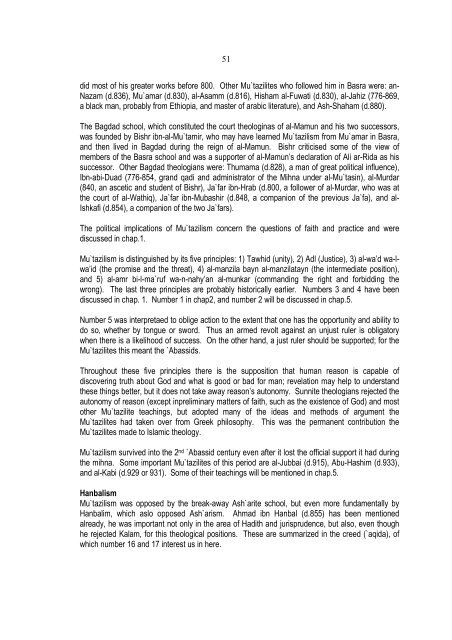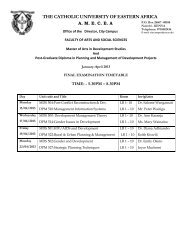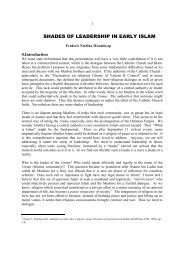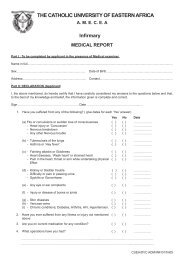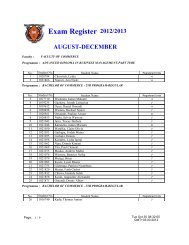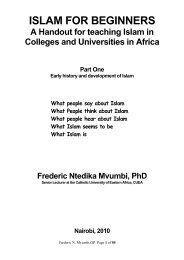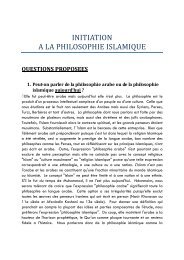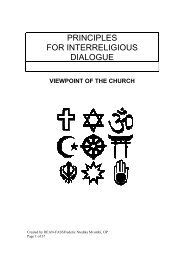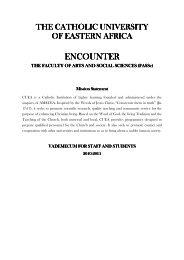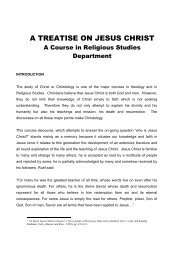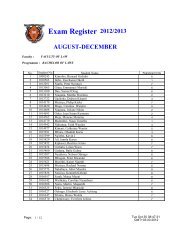INTRODUCTION TO ISLAMIC THEOLOGY.pdf - CUEA
INTRODUCTION TO ISLAMIC THEOLOGY.pdf - CUEA
INTRODUCTION TO ISLAMIC THEOLOGY.pdf - CUEA
You also want an ePaper? Increase the reach of your titles
YUMPU automatically turns print PDFs into web optimized ePapers that Google loves.
51did most of his greater works before 800. Other Mu`tazilites who followed him in Basra were: an-Nazam (d.836), Mu`amar (d.830), al-Asamm (d.816), Hisham al-Fuwati (d.830), al-Jahiz (776-869,a black man, probably from Ethiopia, and master of arabic literature), and Ash-Shaham (d.880).The Bagdad school, which constituted the court theologinas of al-Mamun and his two successors,was founded by Bishr ibn-al-Mu`tamir, who may have learned Mu`tazilism from Mu`amar in Basra,and then lived in Bagdad during the reign of al-Mamun. Bishr criticised some of the view ofmembers of the Basra school and was a supporter of al-Mamun’s declaration of Ali ar-Rida as hissuccessor. Other Bagdad theologians were: Thumama (d.828), a man of great political influence),Ibn-abi-Duad (776-854, grand qadi and administrator of the Mihna under al-Mu`tasin), al-Murdar(840, an ascetic and student of Bishr), Ja`far ibn-Hrab (d.800, a follower of al-Murdar, who was atthe court of al-Wathiq), Ja`far ibn-Mubashir (d.848, a companion of the previous Ja`fa), and al-Ishkafi (d.854), a companion of the two Ja`fars).The political implications of Mu`tazilism concern the questions of faith and practice and werediscussed in chap.1.Mu`tazilism is distinguished by its five principles: 1) Tawhid (unity), 2) Adl (Justice), 3) al-wa’d wa-lwa’id(the promise and the threat), 4) al-manzila bayn al-manzilatayn (the intermediate position),and 5) al-amr bi-l-ma`ruf wa-n-nahy’an al-munkar (commanding the right and forbidding thewrong). The last three principles are probably historically earlier. Numbers 3 and 4 have beendiscussed in chap. 1. Number 1 in chap2, and number 2 will be discussed in chap.5.Number 5 was interpretaed to oblige action to the extent that one has the opportunity and ability todo so, whether by tongue or sword. Thus an armed revolt against an unjust ruler is obligatorywhen there is a likelihood of success. On the other hand, a just ruler should be supported; for theMu`tazilites this meant the `Abassids.Throughout these five principles there is the supposition that human reason is capable ofdiscovering truth about God and what is good or bad for man; revelation may help to understandthese things better, but it does not take away reason’s autonomy. Sunnite theologians rejected theautonomy of reason (except inpreliminary matters of faith, such as the existence of God) and mostother Mu`tazilite teachings, but adopted many of the ideas and methods of argument theMu`tazilites had taken over from Greek philosophy. This was the permanent contribution theMu`tazilites made to Islamic theology.Mu`tazilism survived into the 2 nd `Abassid century even after it lost the official support it had duringthe mihna. Some important Mu`tazilites of this period are al-Jubbai (d.915), Abu-Hashim (d.933),and al-Kabi (d.929 or 931). Some of their teachings will be mentioned in chap.5.HanbalismMu`tazilism was opposed by the break-away Ash`arite school, but even more fundamentally byHanbalim, which aslo opposed Ash`arism. Ahmad ibn Hanbal (d.855) has been mentionedalready, he was important not only in the area of Hadith and jurisprudence, but also, even thoughhe rejected Kalam, for this theological positions. These are summarized in the creed (`aqida), ofwhich number 16 and 17 interest us in here.


